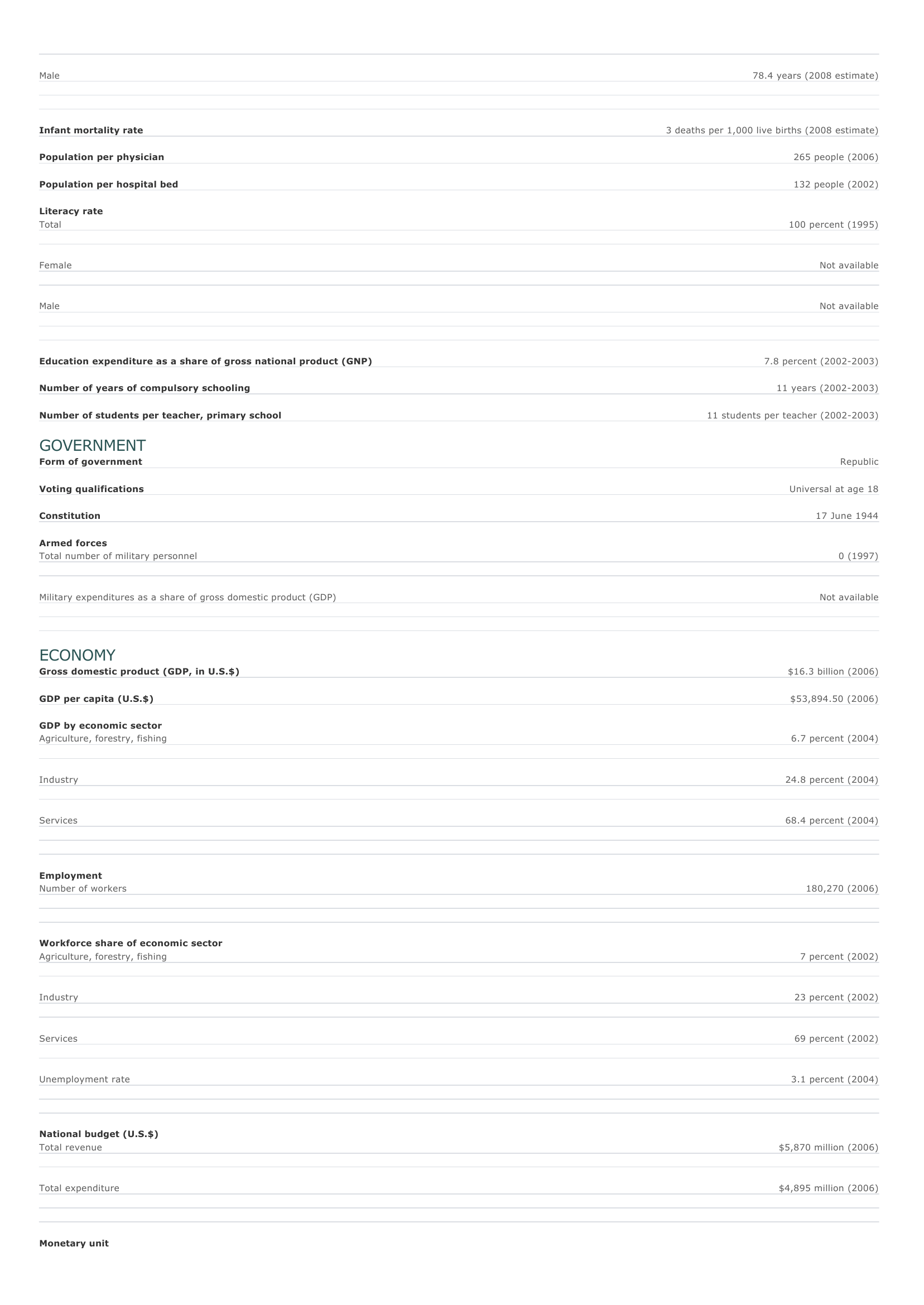Iceland Facts and Figures. BASIC FACTS Official name Capital Area Republic of Iceland Reykjavík 103,000 sq km 39,800 sq mi PEOPLE Population 304,367 (2008 estimate) Population growth Population growth rate 0.78 percent (2008 estimate) Projected population in 2025 337,632 (2025 estimate) Projected population in 2050 350,922 (2050 estimate) Population density Urban/rural distribution Share urban Share rural 3 persons per sq km (2008 estimate) 7.8 persons per sq mi (2008 estimate) 93 percent (2005 estimate) 7 percent (2005 estimate) Largest cities, with population Reykjavík 113,022 (2005 estimate) Kópavogur 25,803 (2005 estimate) Hafnarfjörður 22,000 (2005 estimate) A kureyri 16,308 (2005 estimate) Garðabær 9,053 (2005 estimate) Ethnic groups Homogeneous mixture of descendants of Norwegians and Celts Languages Icelandic (official), Danish, English Religious affiliations Protestant, Evangelical Lutheran (official) 90 percent Independent Christian 4 percent Roman Catholic 1 percent Nonreligious 1 percent O ther 4 percent HEALTH AND EDUCATION Life expectancy Total 80.5 years (2008 estimate) Female 82.8 years (2008 estimate) Male Infant mortality rate 78.4 years (2008 estimate) 3 deaths per 1,000 live births (2008 estimate) Population per physician 265 people (2006) Population per hospital bed 132 people (2002) Literacy rate Total 100 percent (1995) Female Not available Male Not available Education expenditure as a share of gross national product (GNP) Number of years of compulsory schooling Number of students per teacher, primary school 7.8 percent (2002-2003) 11 years (2002-2003) 11 students per teacher (2002-2003) GOVERNMENT Form of government Republic Voting qualifications Universal at age 18 Constitution 17 June 1944 Armed forces Total number of military personnel Military expenditures as a share of gross domestic product (GDP) 0 (1997) Not available ECONOMY Gross domestic product (GDP, in U.S.$) $16.3 billion (2006) GDP per capita (U.S.$) $53,894.50 (2006) GDP by economic sector Agriculture, forestry, fishing 6.7 percent (2004) I ndustry 24.8 percent (2004) Services 68.4 percent (2004) Employment Number of workers 180,270 (2006) Workforce share of economic sector Agriculture, forestry, fishing 7 percent (2002) I ndustry 23 percent (2002) Services 69 percent (2002) Unemployment rate 3.1 percent (2004) National budget (U.S.$) Total revenue $5,870 million (2006) Total expenditure $4,895 million (2006) Monetary unit 1 Icelandic króna (IKr), consisting of 100 aurar Major trade partners for exports United Kingdom, Germany, Netherlands, United States, and Portugal Major trade partners for imports Germany, United States, Denmark, Norway, and United Kingdom ENERGY, COMMUNICATIONS, AND TRANSPORTATION Electricity production Electricity from thermal sources Electricity from hydroelectric sources Electricity from nuclear sources Electricity from geothermal, solar, and wind sources Number of radios per 1,000 people 0.11 percent (2003 estimate) 83.90 percent (2003 estimate) 0 percent (2003 estimate) 15.99 percent (2003 estimate) 1,101 (1999 estimate) Number of telephones per 1,000 people 653 (2005) Number of televisions per 1,000 people 522 (2000 estimate) Number of Internet hosts per 10,000 people 3,790 (2003) Daily newspaper circulation per 1,000 people 336 (1999) Number of motor vehicles per 1,000 people 685 (2004) Paved road as a share of total roads 34 percent (2004) SOURCES Basic Facts and People sections Area data are from the statistical bureaus of individual countries. Population, population growth rate, and population projections are from the United States Census Bureau, International Programs Center, International Data Base (IDB) (www.census.gov). Urban and rural population data are from the Food and Agriculture Organization (FAO) of the United Nations (UN), FAOSTAT database (www.fao.org). Largest cities population data and political divisions data are from the statistical bureaus of individual countries. Ethnic divisions and religion data are largely from the latest Central Intelligence Agency (CIA) World Factbook and from various country censuses and reports. Language data are largely from the Ethnologue, Languages of the World, Summer Institute of Linguistics International (www.sil.org). Health and Education section Life expectancy and infant mortality data are from the United States Census Bureau, International Programs Center, International database (IDB) (www.census.gov). Population per physician and population per hospital bed data are from the World Health Organization (WHO) (www.who.int). Education data are from the United Nations Educational, Scientific and Cultural Organization (UNESCO) database (www.unesco.org). Government section Government, independence, legislature, constitution, highest court, and voting qualifications data are largely from various government Web sites, the latest Europa World Yearbook, and the latest Central Intelligence Agency (CIA) World Factbook. The armed forces data is from Military Balance. Economy section Gross domestic product (GDP), GDP per capita, GDP by economic sectors, employment, and national budget data are from the World Bank database (www.worldbank.org). Monetary unit, agriculture, mining, manufacturing, exports, imports, and major trade partner information is from the statistical bureaus of individual countries, latest Europa World Yearbook, and various United Nations and International Monetary Fund (IMF) publications. Energy, Communication, and Transportation section Electricity information is from the Energy Information Administration (EIA) database (www.eia.doe.gov). Radio, telephone, television, and newspaper information is from the United Nations Educational, Scientific and Cultural Organization (UNESCO) database (www.unesco.org). Internet hosts, motor vehicles, and road data are from the World Bank database (www.worldbank.org). Note Figures may not total 100 percent due to rounding. Microsoft ® Encarta ® 2009. © 1993-2008 Microsoft Corporation. All rights reserved.



